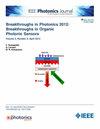Comparisons of Optical Properties of Glucose Sensing by Mueller Matrix Polarimetry Using Infrared and Visible Wavelengths
IF 2.4
4区 工程技术
Q3 ENGINEERING, ELECTRICAL & ELECTRONIC
引用次数: 0
Abstract
A Mueller matrix polarimetry system with 1650 nm wavelength is developed to extract the mean absorbance and anisotropic properties of turbid media as an enabling technology for non-invasive glucose sensing. It shows that the mean absorbance (红外和可见光米勒矩阵偏振法葡萄糖传感光学特性的比较
为实现无创葡萄糖传感技术,开发了一种波长为1650 nm的Mueller矩阵偏振测量系统,用于提取浑浊介质的平均吸光度和各向异性。结果表明,平均吸光度(${{A}_e}$)、去极化指数(Δ)和旋光度(γ)随葡萄糖浓度呈线性变化。这些发现强调了这些参数的相互依赖性及其在表征葡萄糖光学性质方面的重要性。此外,当进行人体测试时,观察到葡萄糖在532 nm波长而不是1650 nm波长表现出明显的时间延迟。此外,还观察到532 nm处葡萄糖的吸收比1650 nm处低。旋光性方面,1650 nm处的响应要比532 nm处清晰得多。这可以解释为在532 nm处的旋光反应比在1650 nm处的旋光反应更容易受到其他干扰物质的干扰,导致相互抵消。在1650 nm波长处,极化系统的平均绝对相对偏差(MARD)值为1.8334%,相关系数(R2)值为0.97629。研究发现,同一组开发的532 nm波长极化系统的MARD和R2值在系统精度和模型线性关系方面分别较差。这些观察结果表明,在人体试验中,使用1650 nm更有效地准确预测葡萄糖的行为。
本文章由计算机程序翻译,如有差异,请以英文原文为准。
求助全文
约1分钟内获得全文
求助全文
来源期刊

IEEE Photonics Journal
ENGINEERING, ELECTRICAL & ELECTRONIC-OPTICS
CiteScore
4.50
自引率
8.30%
发文量
489
审稿时长
1.4 months
期刊介绍:
Breakthroughs in the generation of light and in its control and utilization have given rise to the field of Photonics, a rapidly expanding area of science and technology with major technological and economic impact. Photonics integrates quantum electronics and optics to accelerate progress in the generation of novel photon sources and in their utilization in emerging applications at the micro and nano scales spanning from the far-infrared/THz to the x-ray region of the electromagnetic spectrum. IEEE Photonics Journal is an online-only journal dedicated to the rapid disclosure of top-quality peer-reviewed research at the forefront of all areas of photonics. Contributions addressing issues ranging from fundamental understanding to emerging technologies and applications are within the scope of the Journal. The Journal includes topics in: Photon sources from far infrared to X-rays, Photonics materials and engineered photonic structures, Integrated optics and optoelectronic, Ultrafast, attosecond, high field and short wavelength photonics, Biophotonics, including DNA photonics, Nanophotonics, Magnetophotonics, Fundamentals of light propagation and interaction; nonlinear effects, Optical data storage, Fiber optics and optical communications devices, systems, and technologies, Micro Opto Electro Mechanical Systems (MOEMS), Microwave photonics, Optical Sensors.
 求助内容:
求助内容: 应助结果提醒方式:
应助结果提醒方式:


